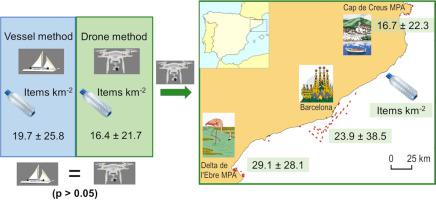Marine Pollution Bulletin ( IF 5.8 ) Pub Date : 2020-07-15 , DOI: 10.1016/j.marpolbul.2020.111467 Odei Garcia-Garin 1 , Asunción Borrell 1 , Alex Aguilar 1 , Luis Cardona 1 , Morgana Vighi 1

|
The aim of the present study was twofold: (i) to validate the drone methodology for floating marine macro-litter (FMML) monitoring, by comparing the results obtained through concurrent drone surveys and visual observations from vessels, and (ii) to assess FMML densities along the North Western Mediterranean Sea using the validated drone surveys. The comparison between monitoring techniques was performed based on 18 concurrent drone/vessel transects. Similar densities of FMML were detected through the two methods (16 items km−2 from the drone method vs 19 items km−2 from the vessel-based visual method). The assessment of FMML densities was done using 40 additional drone transects performed over the waters off the Catalan coast. The densities of FMML observed ranged 0–200 items km−2. These results provide a validation of the use of drones to monitor FMML and contribute to increasing the knowledge about the density of FMML in the North Western Mediterranean Sea.
中文翻译:

地中海西北部漂浮的海洋大型垃圾:联合监测方法的结果。
本研究的目的是双重的:(i)通过比较同时进行的无人机调查和从船上进行的目视观察所获得的结果,验证用于漂浮海洋宏观垃圾(FMML)监控的无人机方法,以及(ii)评估FMML使用经过验证的无人机调查,确定西北地中海沿岸的密度。监视技术之间的比较是基于18个同时进行的无人机/船只样线进行的。通过两种方法检测到了类似的FMML密度(无人机方法为16个项目km -2,而19个项目为km -2来自基于容器的视觉方法)。FMML密度的评估是使用在加泰罗尼亚海岸外海域执行的40个其他无人机样带进行的。观察到的FMML的密度范围为0-200个项目km -2。这些结果证实了使用无人机监测FMML的有效性,并有助于增加对西北地中海海域FMML密度的了解。


























 京公网安备 11010802027423号
京公网安备 11010802027423号